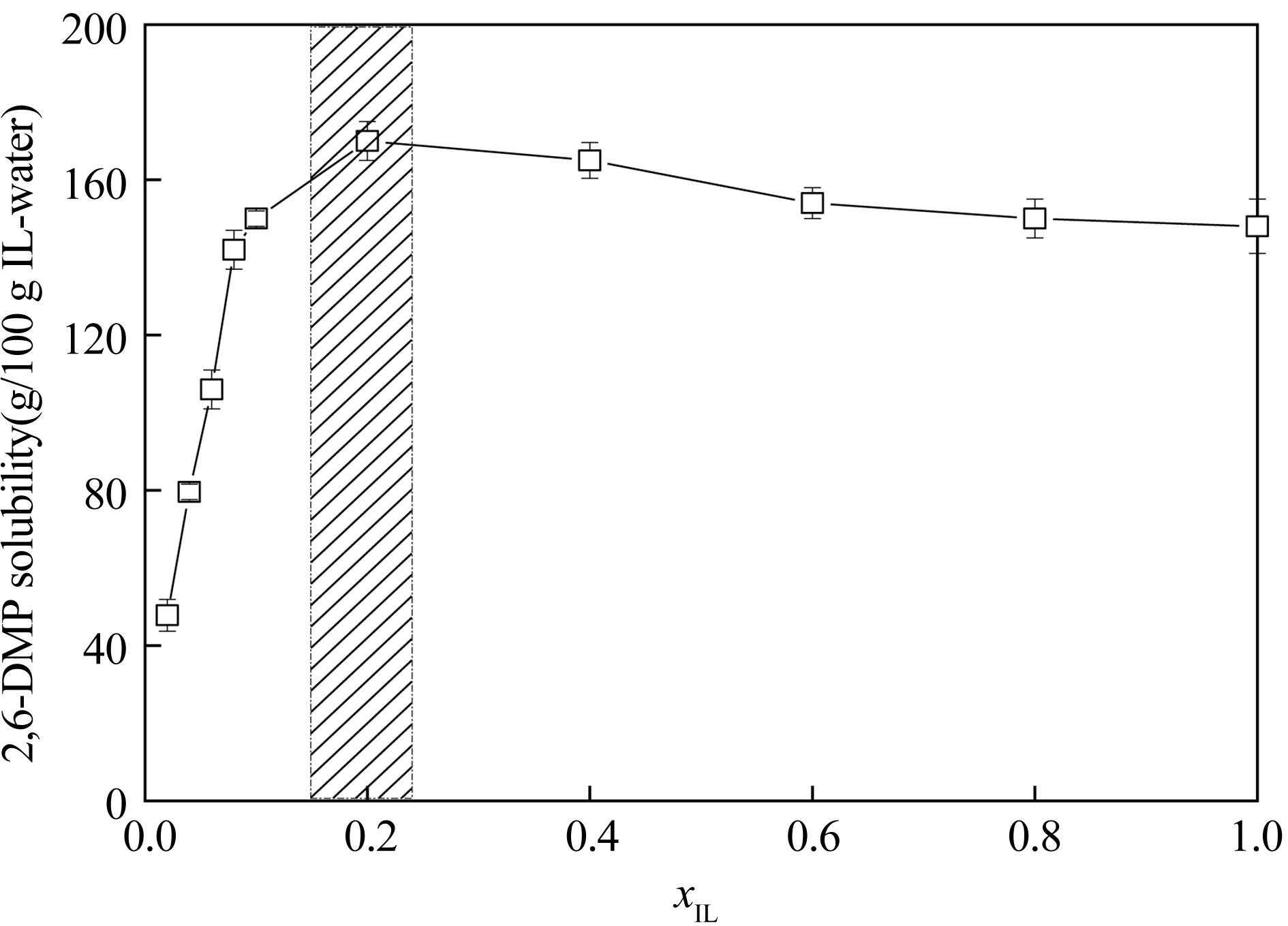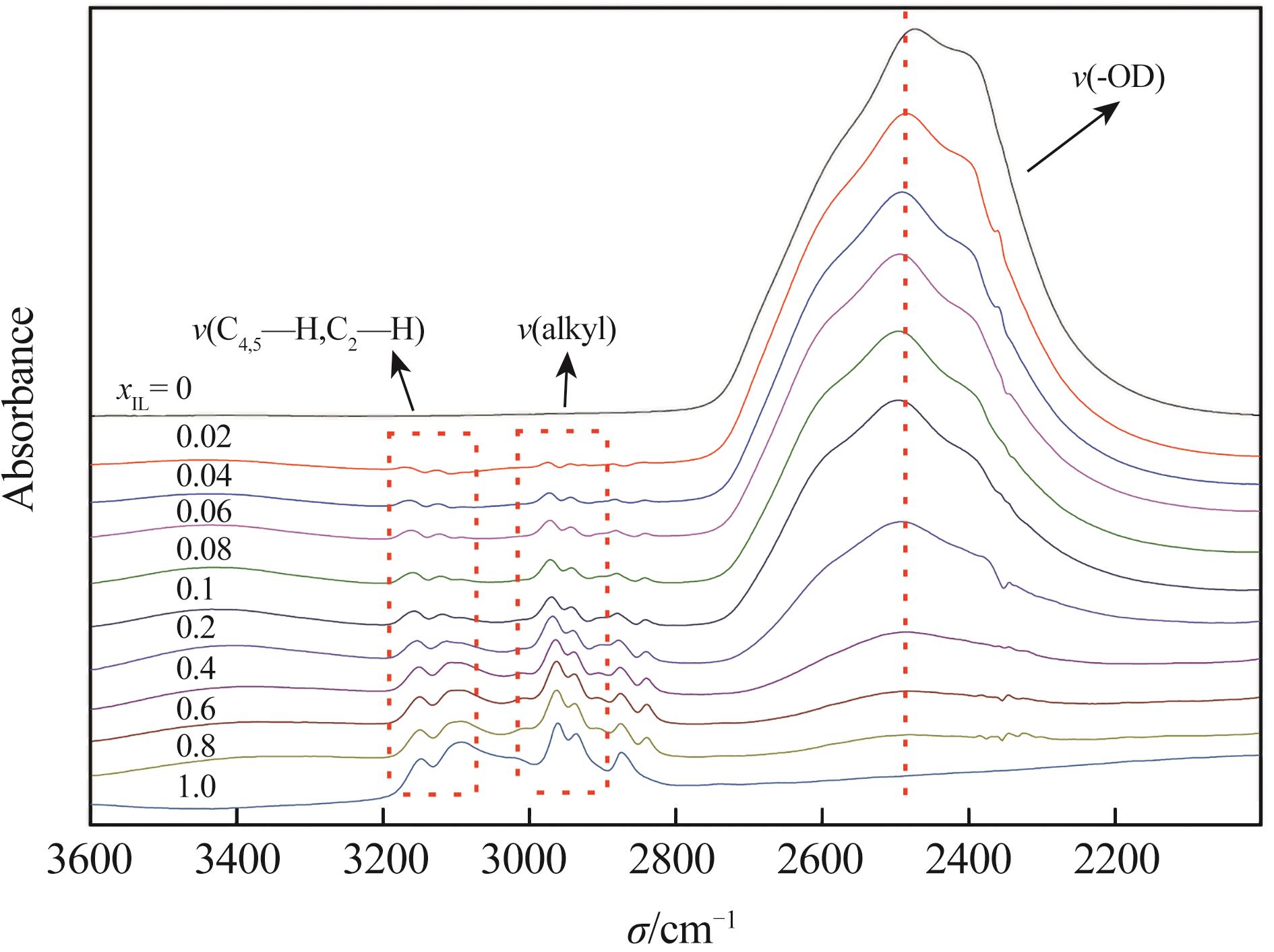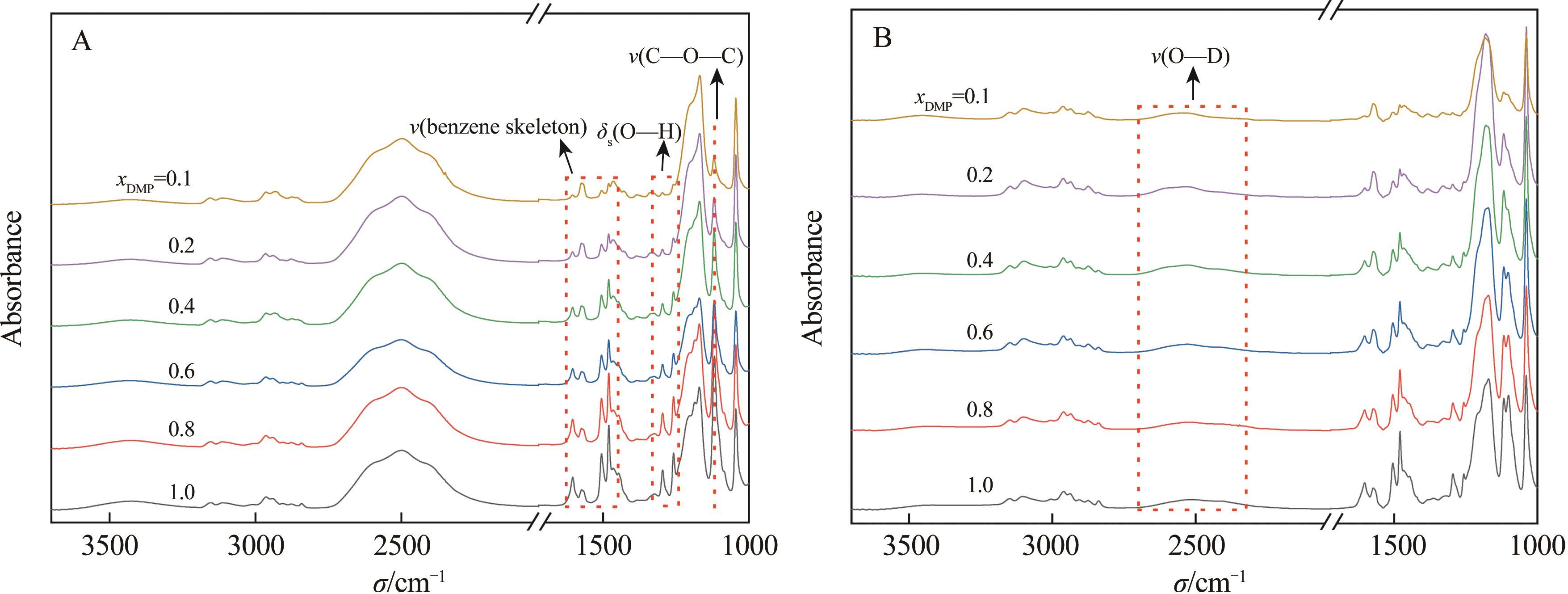
Chinese Journal of Applied Chemistry ›› 2022, Vol. 39 ›› Issue (10): 1600-1609.DOI: 10.19894/j.issn.1000-0518.210567
• Full Papers • Previous Articles Next Articles
Insights into the Dissolution of Lignin Model Phenolic Monomer in 1‑Butyl‑3‑methylimidazolium Methanesulfonate Aqueous Solutions Using Two‑Dimensional Correlation Infrared Spectroscopy
Shuang WU1, De-Yang ZHAO1,2, Sheng-Han WU1, Li-Gang WEI1( ), Na LIU1(
), Na LIU1( ), Qing-Da AN1
), Qing-Da AN1
- 1.School of Light Industry and Chemical Engineering,Dilian Polytechnic University,Dalian 116034,China
2.School of Chemistry and Materials Science,Ludong University,Yantai 264025,China
-
Received:2021-12-16Accepted:2022-03-19Published:2022-10-01Online:2022-10-05 -
Contact:Li-Gang WEI,Na LIU -
About author:linda_liuna@163.com
wlgjoy@163.com;
-
Supported by:the National Natural Science Foundation of China(21776026)
CLC Number:
Cite this article
Shuang WU, De-Yang ZHAO, Sheng-Han WU, Li-Gang WEI, Na LIU, Qing-Da AN. Insights into the Dissolution of Lignin Model Phenolic Monomer in 1‑Butyl‑3‑methylimidazolium Methanesulfonate Aqueous Solutions Using Two‑Dimensional Correlation Infrared Spectroscopy[J]. Chinese Journal of Applied Chemistry, 2022, 39(10): 1600-1609.
share this article
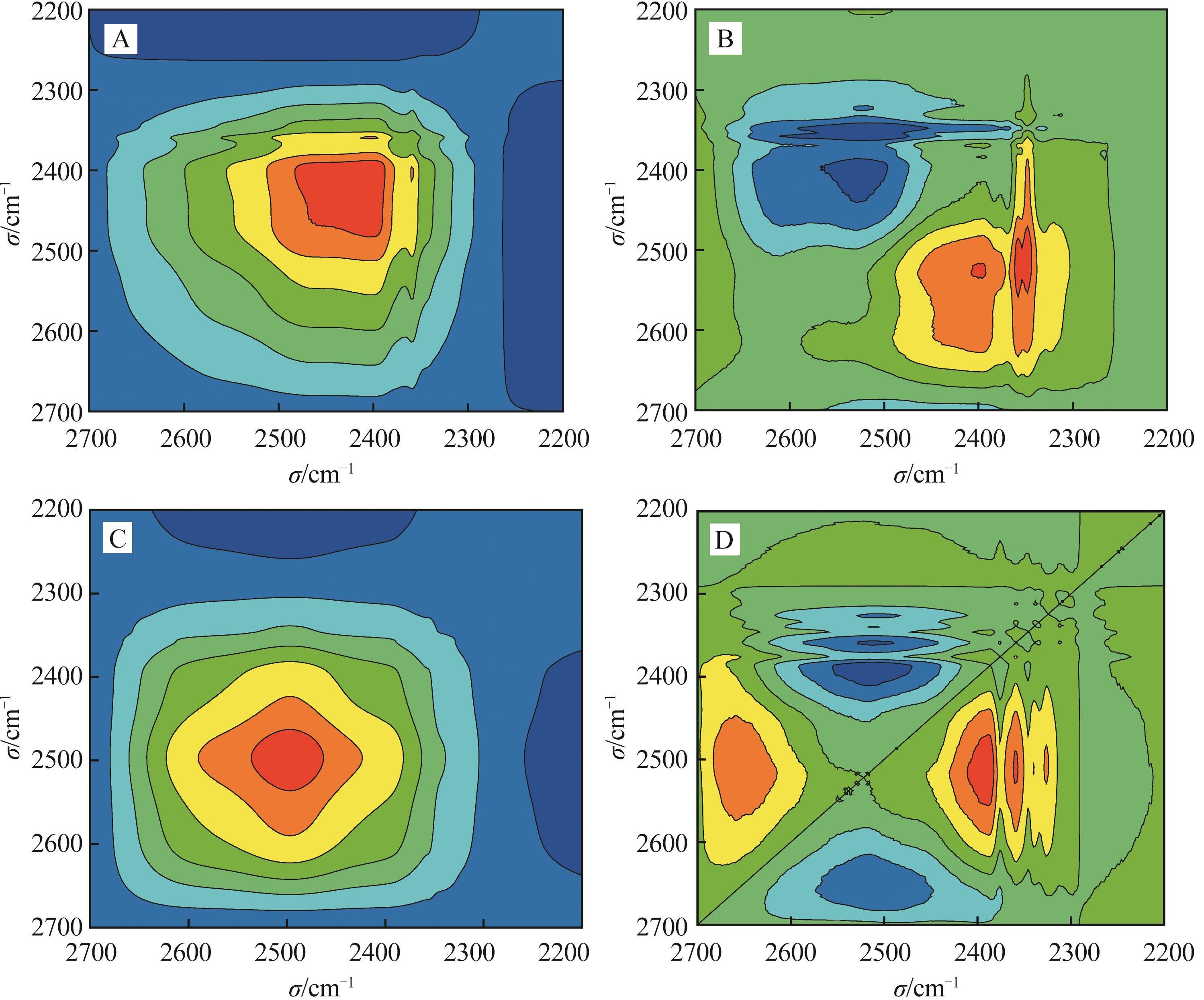
Fig.4 2D-IR spectra (synchronous (A,C) and asynchronous (B,D)) of [C4mim]CH3SO3-D2O-2,6-DMP ternary system in the O—D stretching region with xIL ranging from 0.02 to 0.20 (A,B) and 0.20 to 1.0 (C,D)
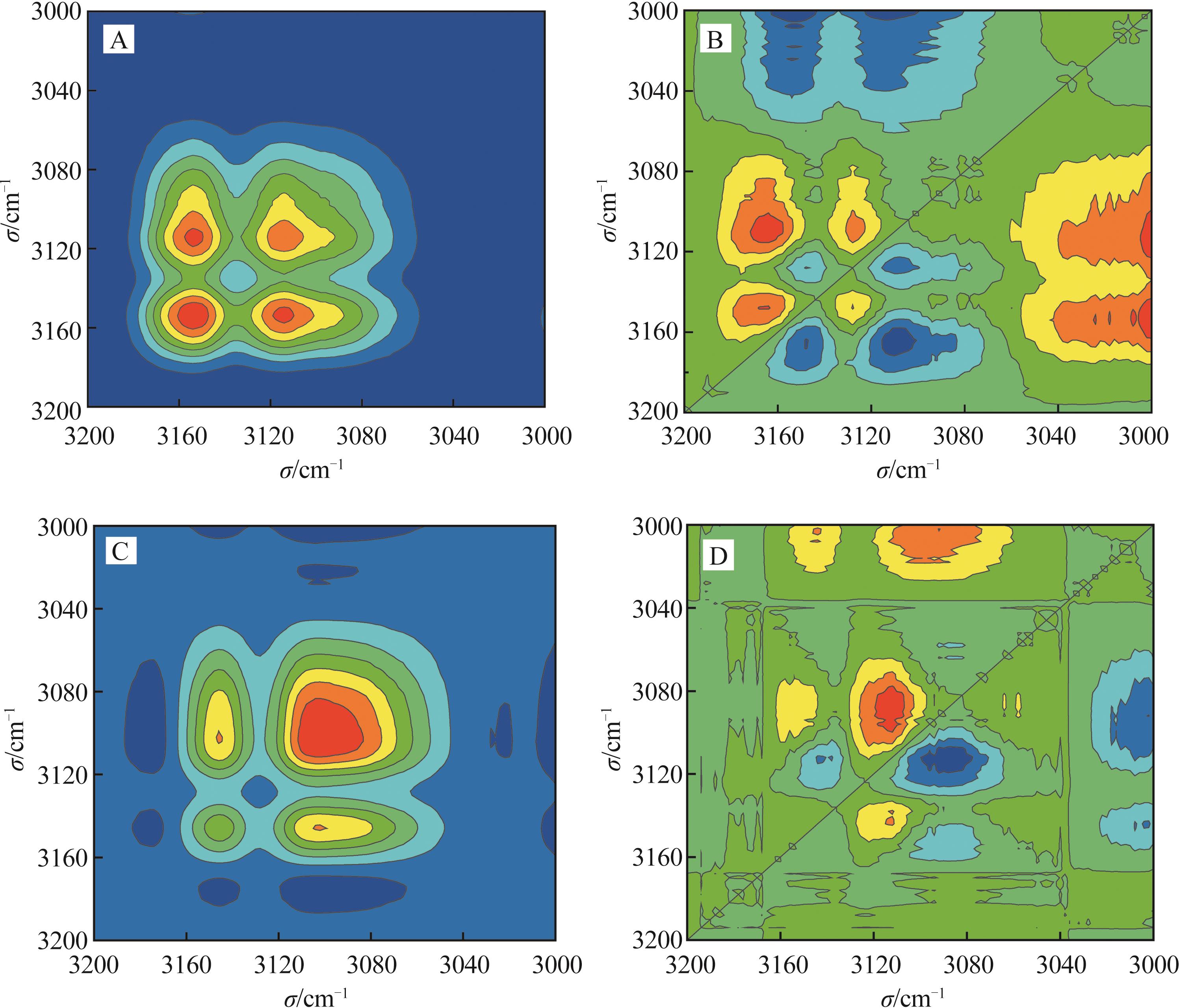
Fig.5 2D-IR spectra (synchronous (A, C) and asynchronous (B, D))of [C4C1im]CH3SO3-D2O-2,6-DMP ternary system in the C—H stretching region with xIL ranging from0.02 to 0.20 (A, B) and 0.20 to 1.0 (C, D)
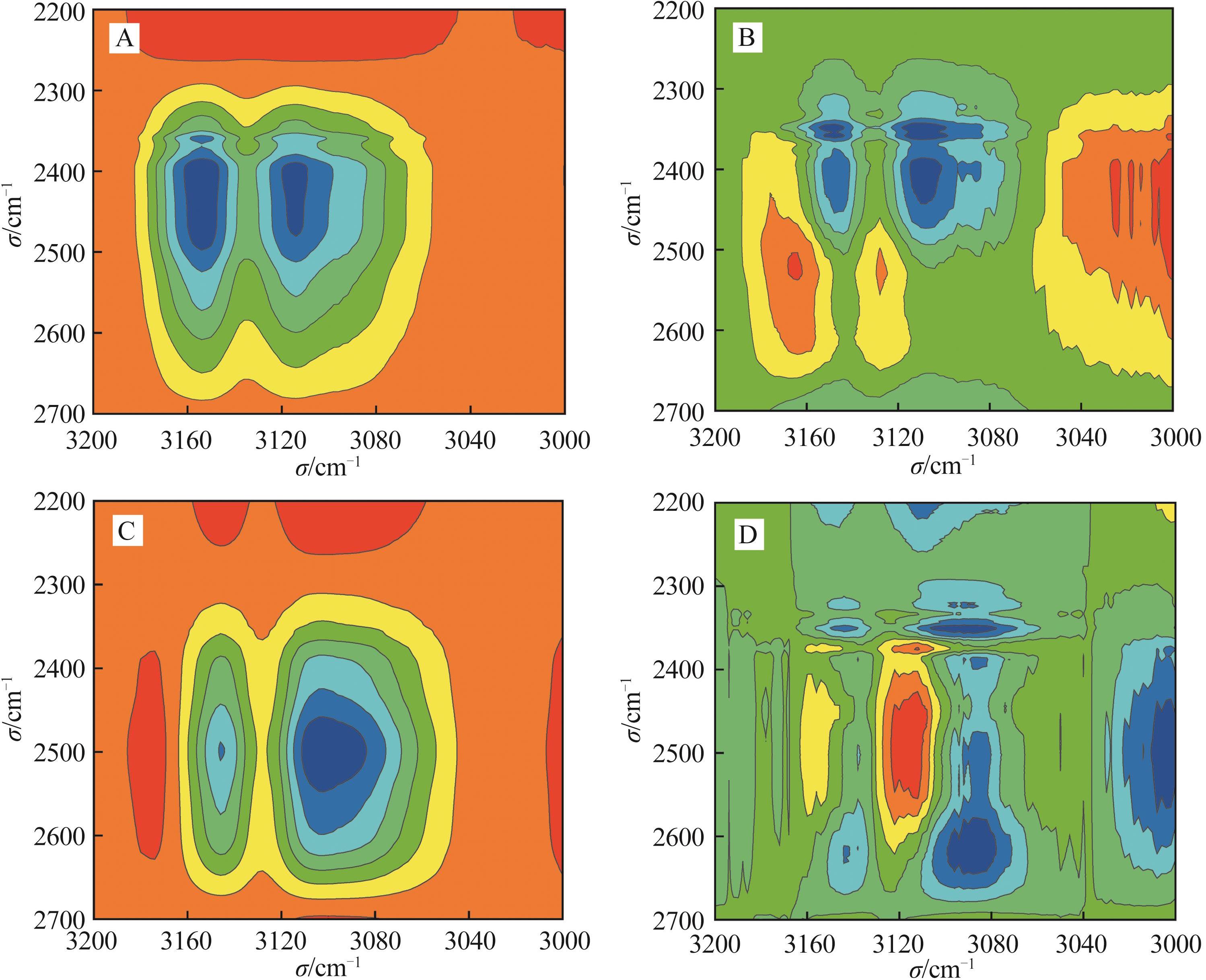
Fig.6 2D-IR spectra (synchronous (A, C) and asynchronous (B, D))of [C4C1im]CH3SO3-D2O-2,6-DMP ternary system in the O—D and C—H stretching region with xIL ranging from0.02 to 0.20 (A, B) and 0.20 to 1.0 (C, D)
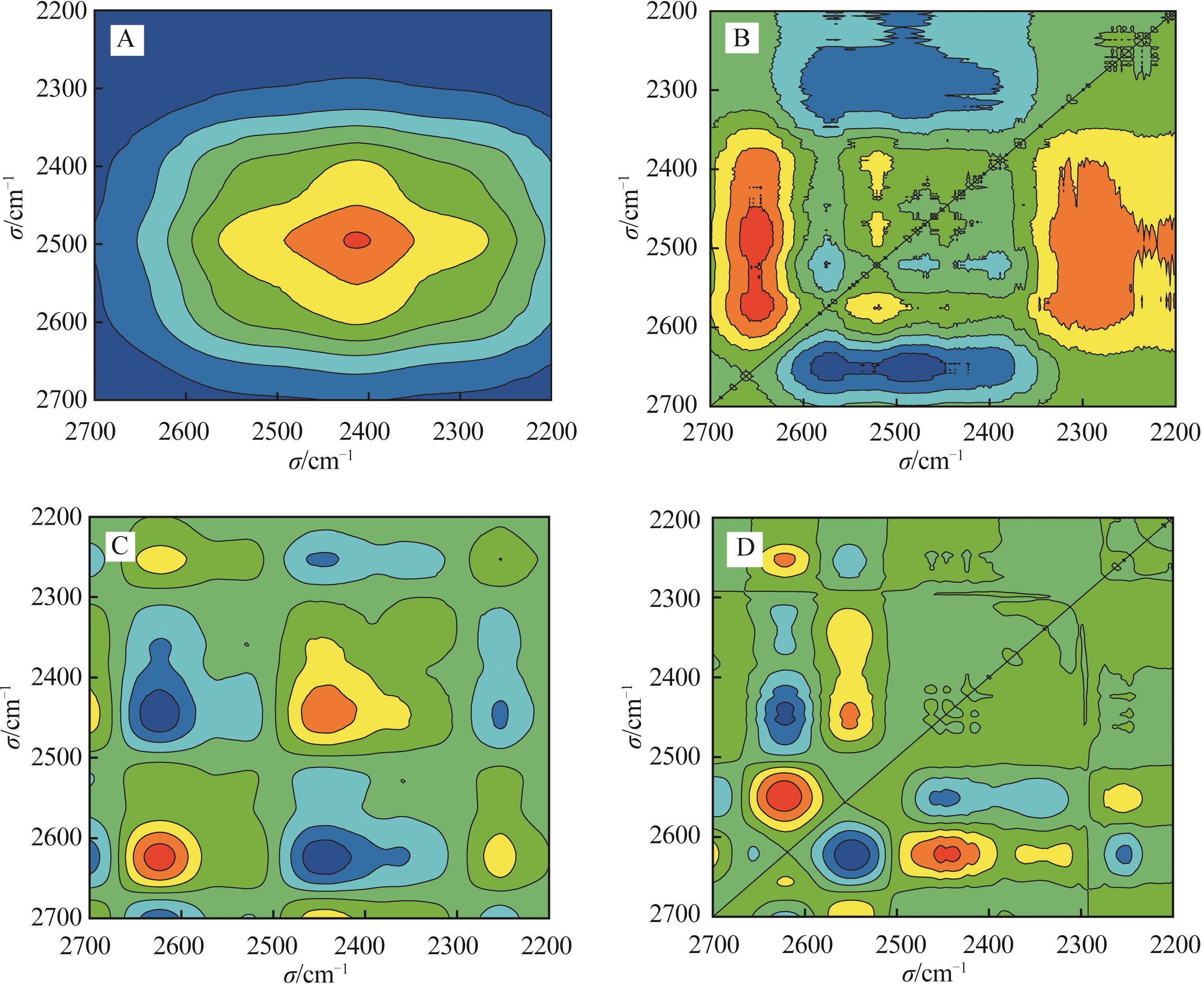
Fig.7 2D-IR spectra(synchronous (A, C) and asynchronous (B, D)) of [C4C1im]CH3SO3-D2O-2,6-DMP ternary system in the O—D stretching region with xIL =0.10 (A,B) and 0.60 (C,D)
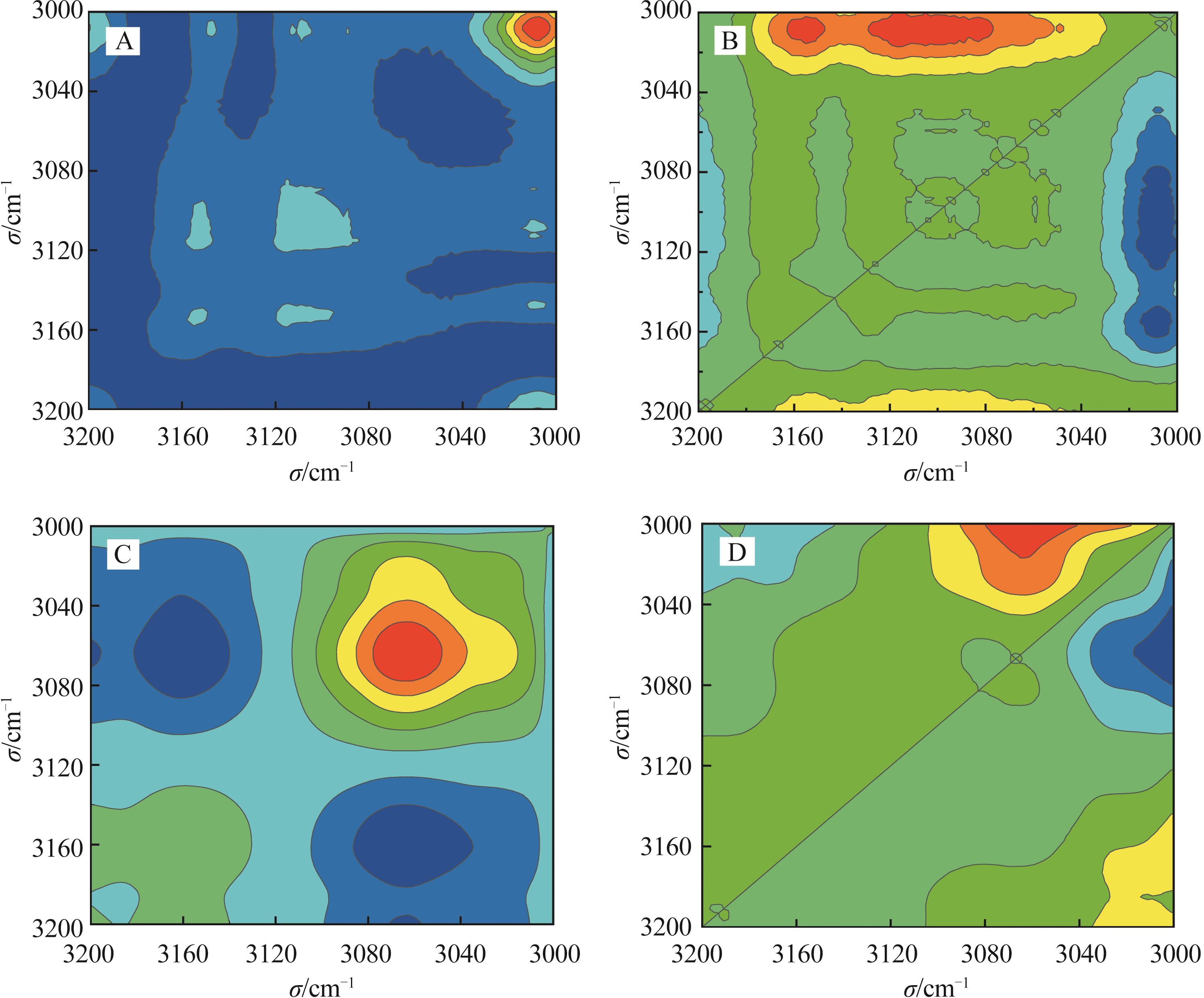
Fig.8 2D-IR spectra(synchronous (A, C) and asynchronous (B, D)) of [C4C1im]CH3SO3-D2O-2,6-DMP ternary system in the C—H stretching region with xIL =0.10 (A, B) and 0.60 (C, D)
| 1 | ARAYA-FARIAS M, HUSSON E, SAAVEDRA-TORRICO J, et al. Wheat bran pretreatment by room temperature ionic liquid-water mixture: optimization of process conditions by pls-surface response design[J]. Front Chem, 2019, 7: 585. |
| 2 | GSCHWEND F J V, HALLETT J P, BRANDT-TALBOT A, et al. Exploring the effect of water content and anion on the pretreatment of poplar with three 1-ethyl-3-methylimidazolium ionic liquids[J]. Molecules, 2020, 25(10): 2318. |
| 3 | AKIBA T, TSURUMAKI A, OHNO H. Induction of lignin solubility for a series of polar ionic liquids by the addition of a small amount of water[J]. Green Chem, 2017, 19(9): 2260-2265. |
| 4 | XU A R, GUO X, ZHANG Y B, et al. Efficient and sustainable solvents for lignin dissolution: aqueous choline carboxylate solutions[J]. Green Chem, 2017, 19(17): 4067-4073. |
| 5 | DONG X Y, CAO Y F, WANG N F, et al. Systematic study on solubility of chrysin in different organic solvents: the synergistic effect of multiple intermolecular interactions on the dissolution process[J]. J Mole Liquids, 2021, 325: 115180. |
| 6 | YAMAMOTO Y, HOSHINA H, SATO H. Differences in intermolecular interactions and flexibility between poly(ethylene terephthalate) and poly(butylene terephthalate) studied by far-infrared/terahertz and low-frequency Raman spectroscopy[J]. Macromolecules, 2021, 54(2): 1052-1062. |
| 7 | AZLAH M, CHUA L S, ABDULLAH F I, et al. A fast and reliable 2D-IR spectroscopic technique for herbal leaves classification[J]. Vibrat Spectrosc, 2019, 106: 103014. |
| 8 | ZHANG L Q, XU Z, WANG Y, et al. Prediction of the solvation and structural properties of ionic liquids in water by two-dimensional correlation spectroscopy[J]. J Phys Chem B, 2008, 112(20): 6411-6419. |
| 9 | CHEN Y, YAN C Y, MA X H, et al. Evolutional mechanism of 1-ethyl-3-methyl-imdazolium acetate uptaking water from air detected with a new coupled method: two-dimensional correlation difference spectroscopy[J]. J Mole Liquids, 2015, 203: 169-180. |
| 10 | FAN H L, YANG Y Y, MENG Q L, et al. Ionic liquid [OMIm][OAc] directly inducing oxidation cleavage of the β-O-4 bond of lignin model compounds[J]. Chem Commun, 2017, 53(63): 8850-8853. |
| 11 | WANG Y T, WEI L G, LI K L, et al. Probing molecular interactions in 1-butyl-3-methylimidazolium chloride-water and 2,6-dimethoxyphenol mixtures using attenuated total reflection infrared spectroscopy[J]. Chinese J Chem Phys, 2017, 30(5): 521-528. |
| 12 | CLAUDIO A F M, FERREIRA A M, FREIRE C S R, et al. Optimization of the gallic acid extraction using ionic-liquid-based aqueous two-phase systems[J]. Separat Purif Technol, 2012, 97: 142-149. |
| 13 | SINTRA T E, SHIMIZU K, VENTURA S P, et al. Enhanced dissolution of ibuprofen using ionic liquids as catanionic hydrotropes[J]. PCCP, 2018, 20: 2094-2103. |
| 14 | WANG Y T, WEI L G, LI K L, et al. Lignin dissolution in dialkylimidazolium-based ionic liquid-water mixtures[J]. Bioresource Technol, 2014, 170: 499-505. |
| 15 | 金盈, 苏朝晖. 二维红外光谱研究聚碳酸酯薄膜中水的扩散[J]. 应用化学, 2011, 28(1): 16-21. |
| JIN Y, SU Z H. Water diffusion in polycarbonate film studied by 2D FTIR spectroscopy[J]. Chinese J Appl Chem, 2011, 28(1): 16-21. | |
| 16 | 林浩坚, 刘刚, 杨卫梅, 等. 二维相关红外光谱分析鉴别不同产地黑木耳[J]. 中国农业科技导报, 2019, 21(1): 154-163. |
| LIN H X, LIU C, YANG W M, et al. Discrimination of auricularia auricula from different producing areas with two-dimensional correlation infrared spectroscopy[J]. J Agric Sci Technol, 2019, 21(1): 154-163. | |
| 17 | BAILEY H E, WANG Y L, FAYER M D, et al. Impact of hydrogen bonding on the dynamics and structure of protic ionic liquid/water binary mixtures[J]. J Phys Chem B, 2017, 121(36): 8564-8576. |
| 18 | 李丹, 苏晓声, 张驰. 二维红外相关光谱在双氰胺固化环氧树脂体系中的应用[J]. 应用化学, 2015, 32(11): 1275-1282. |
| LI D, SU X S, ZHANG C. Application of two-dimensional fourier transform infrared correlation spectroscopy on dicyandiamide-epoxy network[J]. Chinese J Appl Chem, 2015, 32(11): 1275-1282. | |
| 19 | NODA I, OZAKI Y. Two-dimensional correlation spectroscopy: applications in vibrational and optical spectroscopy[M]. John Wiley & Sons, 2004. |
| 20 | WANG N N, ZHANG Q G, WU F G, et al. Hydrogen bonding interactions between a representative pyridinium-based ionic liquid [BuPy][BF4] and water/dimethyl sulfoxide[J]. J Phys Chem B, 2010, 114(26): 8689-8700. |
| 21 | 宋大勇, 陈静. 离子液体1-乙基-3-甲基咪唑三氟甲基磺酸盐与水之间的氢键作用[J]. 物理化学学报, 2014, 30(9): 1605-1610. |
| SONG D Y, CHEN J. Hydrogen-bonding interactions between ionic liquid 1-ethyl-3-methylimidazolium trifluoromethanesulfonate and water[J]. Acta Phys-Chim Sin, 2014, 30(9): 1605-1610. | |
| 22 | 赵德扬, 魏立纲, 李坤兰, 等. 2,6-二甲氧基苯酚在1-丁基-3-甲基咪唑四氟硼酸盐水溶液中溶解行为的红外光谱分析[J]. 化工学报, 2015, 66(S1): 54-59. |
| ZHAO D Y, WEI L G, LI K L, et al. Understanding dissolution behavior of 2,6-dimethoxyphenol in 1-butyl-3-methylimidazolium tetrafluoroborate aqueous solutions by infrared spectroscopy[J]. CIESC J, 2015, 66(S1): 54-59. |
| [1] | Yu-Wen YANG, Jing-Yao QI, Lin LI, Guo-Ning CHU, Sai WANG, Yu ZHANG, Shuang ZHANG. Selective Oxidation of 5-Hydroxymethylfurfural to 2,5-Furandicarboxylic Acid over Ru Supported on Magnetic NiFe2O4 [J]. Chinese Journal of Applied Chemistry, 2023, 40(6): 879-887. |
| [2] | Ning YUAN, Jie MA, Jin-Ling ZHANG, Jian-Sheng ZHANG. Preparation of PCN-6(M) Bimetallic Organic Framework Materials by Steam-assisted Method and Their CO2 and CH4 Adsorption Performance [J]. Chinese Journal of Applied Chemistry, 2023, 40(6): 896-903. |
| [3] | Hai-Xiang XIU, Wan-Qiang LIU, Dong-Ming YIN, Yong CHENG, Chun-Li WANG, Li-Min WANG. Research Progress of AB2 Laves Phase Hydrogen Storage Alloys [J]. Chinese Journal of Applied Chemistry, 2023, 40(5): 640-652. |
| [4] | Xue-Bo LEI, Hui-Jing LIU, He-Yu DING, Guo-Dong SHEN, Run-Jun SUN. Research Progress on Photocatalysts for Degradation of Organic Pollutants in Printing and Dyeing Wastewater [J]. Chinese Journal of Applied Chemistry, 2023, 40(5): 681-696. |
| [5] | Lin YANG, Hui PAN, Ding-Feng GAO, Xiao-Dong WANG. Preparation and Characterization of Nanocomposite Leather Finishing Agent Based on Aramid Modified Polymer [J]. Chinese Journal of Applied Chemistry, 2023, 40(5): 708-719. |
| [6] | Yu FANG, Wang-Qiang KUANG, Sheng-Ting KUANG, Wu-Ping LIAO. Selective Extraction and Recovery of Copper from the Leaching of Low-grade Copper Ore by H2SO4-NaCl Solution Using Cextrant 230 [J]. Chinese Journal of Applied Chemistry, 2023, 40(5): 758-768. |
| [7] | Li-Juan YAN, Tian-He GAO, Dong-Jian SHI, Ming-Qing CHEN. Preparation and Properties of Eugenol/Modified Polyvinyl Alcohol Antibacterial Composite Films [J]. Chinese Journal of Applied Chemistry, 2023, 40(4): 527-535. |
| [8] | Hui-Hui LI, Kai-Sheng YAO, Ya-Nan ZHAO, Li-Na FAN, Yu-Lin TIAN, Wei-Wei LU. Ionic Liquid-Modulated Synthesis of Pt-Pd Bimetallic Nanomaterials and Their Catalytic Performance for Ammonia Borane Hydrolysis to Generate Hydrogen [J]. Chinese Journal of Applied Chemistry, 2023, 40(4): 597-609. |
| [9] | Qi-Hang CHEN, Fei-Jian XU, Feng WANG, Shuang-Chan FU, Ying-Hao YU. Research Progress of Deep Eutectic Solvent and Its Application Prospects as Antistatic Agents [J]. Chinese Journal of Applied Chemistry, 2023, 40(3): 341-359. |
| [10] | Nan-Yu LIN, Feng GAO, Jiang-Ying QU, Jing-Jing TU, Wei-Jun ZHONG, Yun-Hao ZANG. Preparation of Super-hydrophilic/Underwater Oil-phobic High Silicon Cloth and Its Oil-water Separation Performance [J]. Chinese Journal of Applied Chemistry, 2023, 40(3): 449-459. |
| [11] | Hua-Yu WANG, Chao ZHANG, Ke-Ming CHEN, Ming GE. Research Progress of Metal-organic Framework MIL-88A(Fe) and Its Composites in Water Treatment [J]. Chinese Journal of Applied Chemistry, 2023, 40(2): 155-168. |
| [12] | Mou-Cui LI, Yang-Ming DONG, Ying-Hui REN, Hai-Xia MA, Le QI. Synthesis, Antifungal Activity and Molecular Docking Study of 1,2,4-Triazole Bis-Schiff Base Derivatives [J]. Chinese Journal of Applied Chemistry, 2023, 40(1): 116-125. |
| [13] | Yan-Qin CHENG, Zhuo-Xi LI, You-Di WANG, Juan-Juan XU, Zheng BIAN. Structurally Simplified 4-Hydroxyprolinamide for Highly Efficient Asymmetric Michael Addition of Aldehydes to Nitroolefins [J]. Chinese Journal of Applied Chemistry, 2023, 40(1): 146-154. |
| [14] | Xin ZHAO, He LIU, Zhong-Bo WU, He WANG, Zi-Ming WANG. Determination of Methyl‑mercury by Microwave Assisted Extraction‑Solid Phase Membrane Extraction in Water Sediments [J]. Chinese Journal of Applied Chemistry, 2022, 39(9): 1360-1370. |
| [15] | Xiao-Jian DING, Cong-Jun CAO, Cheng-Min HOU, Han-Xiao MA, Jiao HU, Meng-Jie REN, Guo-Yong YANG. Preparation and Performance of Environmentally Friendly Fluorine⁃Free Superhydrophobic Fabric for Oil/Water Separation [J]. Chinese Journal of Applied Chemistry, 2022, 39(9): 1391-1400. |
| Viewed | ||||||||||||||||||||||||||||||||||||||||||||||||||
|
Full text 585
|
|
|||||||||||||||||||||||||||||||||||||||||||||||||
|
Abstract 428
|
|
|||||||||||||||||||||||||||||||||||||||||||||||||
